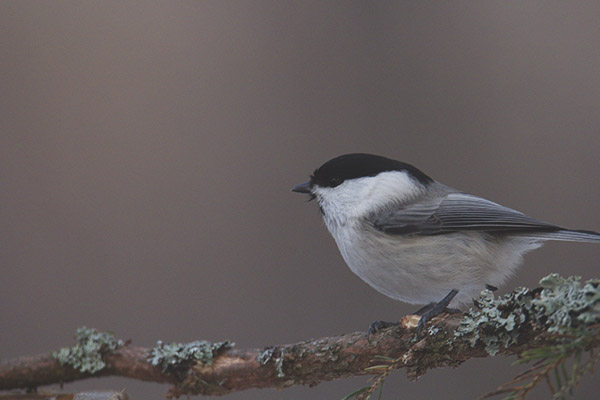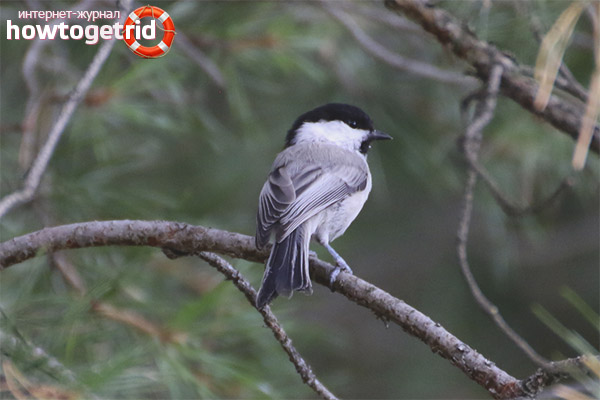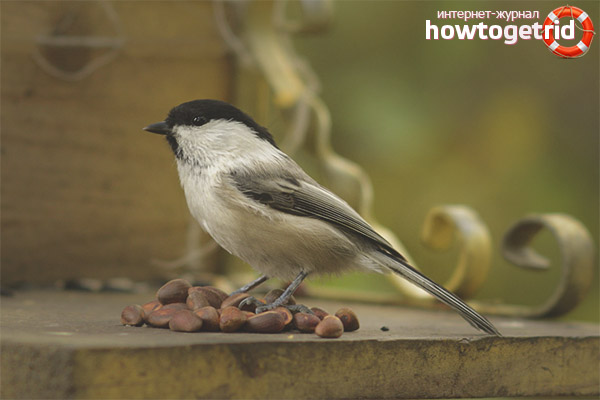The content of the article
The little tit is meant a bird belonging to the family Titmouse. On the territory of our homeland of these individuals, everyone knows everything under the name "puffy". This name came to the birds at the expense of their features to constantly fluff feathers when it is cold outside. Birds prefer to dwell in European and Asian countries. They settle not in densely populated areas, like wilderness. In today's material we will look at everything related to these birds. Where they prefer to live, as they nest and feed.
Description
- In terms of body format, individuals are rounded, their mass hardly exceeds the figures of 15 grams. with a body length of 15 cm. The neck is short, depressed. The body feathers are brown-gray. The head is round and large, the occipital part is excreted, pigmented by black feathers without gloss.
- The back is mostly painted gray with brown.The same shade area above the tail, wings, shoulders and lumbar. The cheeks are colored gray with white patches. The neck in the sides is ocher.
- The front of the neck has a black spot. The beak is pigmented with dark brown color. The bottom of the case is white, dirty. On the sides of the abdominal cavity, ocher tones of plumage are seen. Paws are dark, gray.
- For an inexperienced person in a field, it is quite difficult to distinguish this tit from a blackhead. The difference lies only in the haze of the cap located on the head. Also in the species under discussion, there is an oblong strip on the wings, which is colored gray.
Singing
- A distinctive feature of the birds of this breed is their beautiful singing. There are no various notes in the vocals, unlike the blackheads. There are several basic types of songs. The first is the songs that protect the territory. The second is a demonstration of their skills in front of females in the mating season.
- When males attract the opposite sex, they make sounds like “tii” or “tyi”. Periodically, one tone is replaced by another.Singing is performed all year round, but, as a rule, you can hear birds in spring or summer (closer to autumn).
- The whistle saying that the territory is occupied is somewhat different. He is not so shrill and loud. Something similar to the sound of the drill, alternating with a squeak. Most often, territorial songs are performed by males defending their possessions.
- If we follow the data obtained from the ornithologists, then we distinguish the so-called bubbling song. It is composed of coarse sounds like "j" or "tsts".
Habitat
- The family most often discussed is found on the territory of Eurasia. You can find birds in the central part of France, as well as in the east of Great Britain. The range extends to the Japanese islands and the Pacific Ocean. On the northern side, you can find feathered friends in woody vegetation. They like the tundra of Scandinavia and Finland.
- In the southern part are in the steppe zones. Also attract these individuals slopes and flat areas, coniferous and deciduous stripes. In mixed forests are found where there are pines. Settled near wetlands and floodplains. As for Siberia, there they are found next to willows, alder.
- In Europe, they are found on the edges, among the vast thickets of bushes and groves. They can also live in the mountains, there are individuals living at an altitude of up to 2.5 thousand meters. When the breeding season ends, or it has not yet begun, the individuals live much higher than this mark. In Tibet, chubby dwell over the sea in a height of up to 3.5 thousand meters.
- As for lifestyle, individuals prefer to build nests for future offspring in the middle or late spring. For nests choose hollow rotted or dead trees. Also, the construction can be carried out on the stumps. Gaichs are somewhat similar to woodpeckers, they drill a place in a tree with their beak.
- The considered individuals build dwellings in hollows, the depth of which is 20-25 cm. At the same time, the diameter is only about 7 cm. Such birds are often broken into pairs in the autumn. After that, they begin to jointly engage in the arrangement of the nest.
- In the first year of puberty, the males try to find a mate on their territory. Often this area does not exceed 5 km. If the males did not succeed, they begin to fly to other lands in search of a companion.
- As soon as a full-fledged couple has formed, the birds will settle the dwelling for about 10 days.As a building material, individuals use bark, tree bark, branches, feathers and animal hair.
- Ready-made houses of chubby are different from the nests of other birds of this type in that they do not insulate the bottom of their home with moss. In addition, birds often make hiding places where plant seeds are left. However, birds often forget about these caches.
Nutrition
- The basis of the diet of individuals includes insect larvae and small invertebrates. As a result of such nutrition, birds are of great benefit to the forest ecosystem. Individuals regulate the number of insects and small pests. In addition, the birds ’diet often includes seeds and fruits of plants.
- In the summer, the birds discussed share their diet in equal parts. The menu includes vegetable and animal products. As for the cold season, individuals mostly eat seeds of spruce, pine and juniper.
- With the advent of offspring, parents begin to feed the young with caterpillars, spiders and some products of plant origin.At this time, adults often eat tasty mosquitoes, bees, flies, earthworms, ants, snails, weevils, and even mites.
- As for food of plant origin, in this case, birds prefer oats, corn, barley and wheat. Also, birds like berries. They often savor cranberries, dogwoods, rowan and blueberries. As for feeders, birds visit them very rarely.
Breeding
- During the construction of the nests in birds the mating season also begins. In this case, after forming a pair, the partners remain faithful to each other until one of them dies. With good conditions and without the threat to the life of birds, they can safely live up to 10 years.
- During the mating season, the courtship of the males for females manifests itself in the form of shaking feathers and accompanying songs. Before the formed pair begins to mate, the males defiantly bring their beloved fodder.
- Before the beginning of laying, individuals always re-equip the nest. As a result, the bottom of the dwelling is covered with bedding before vysydka In laying can be up to 9 eggs. Often they are white with red patches.
- Vidiska takes up to 2 weeks.All this time, the male protects the home and family, produces food for himself and the female. Juveniles begin to spit on the light for 2.3 days. After this, the parents feed the offspring together.
Considered individuals monogamous. They are caring for their offspring. On cool nights, the female is constantly near the chicks, warming them. During the day, the male protects the family and brings them food.
Video: Willow Tit (Poecile montanus)













To send